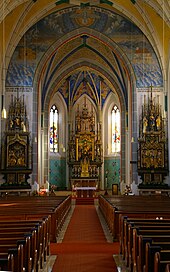St. Nicholas (overseas)
The parish church of St. Nikolaus in Übersee , a parish in the Upper Bavarian district of Traunstein , is a church that was built in the neo-Gothic style at the beginning of the 20th century .
history
The parish church of St. Nikolaus was built from 1902 to 1904 according to plans by the Munich architect Joseph Elsner in neo-Gothic style during the term of office of Pastor Kaspar Kreitlhuber. After the laying of the foundation stone on August 15, 1902, the inauguration took place on September 25, 1904 by the Archbishop of Munich , Franz Joseph von Stein .
The stately church was built in neo-Gothic style as one of the last places of worship in Bavaria. The building was able to survive the period that rejected historicism after the middle of the 20th century unscathed and was therefore included in the list of historical monuments of the Bavarian State Office for the Preservation of Monuments because of the uniform, original furnishings .
Because of its size, the church is also known as the cathedral of the Achental .
Building description
The church was built on the site of the previous church in the middle of a walled cemetery. It is an unplastered neo-Gothic brick building with a six-axis nave and the strongly recessed, lower choir with a 5/8 end . The 75 m high tower is on the west side of the nave. On both sides of the nave are the portals with the vestibules, the choir below and above the sacristy and side chapel, which give the church a cross-shaped floor plan like a transept. The church is 50 m long, 15 m wide and 18 m high.
Furnishing
The neo-late Gothic high altar represents St. Nicholas as the patron saint of the needy family, as well as the figures of St. Archangel Michael and St. Georg and in the sprinkling a crucifixion group. It was executed in 1905 by the Munich sculptor Josef Auer according to designs by Joseph Elsner and donated by Baron Theodor von Cramer-Klett from Hohenauschau. The side altars, also designed in neo-late Gothic style, are a joint work of Joseph Elsner and Josef Auer. The left side altar depicts Mother Anna with Mary and the baby Jesus. It is adorned with the figures of St. Joachim and St. Joseph as well as God the Father and the dove of the Holy Spirit. Saints Barbara, Elisabeth and Katharina are depicted in the burst. The right side altar shows Mary with the baby Jesus Maria. On the side the figures of Saints Florian and Sebastian and in the bursts of Saint Stephen, King Ludwig and Laurentius can be seen.
The neo-Gothic altar of the weekday chapel with the figure of the Sorrowful Mother of God and crucifix as well as the paintings of the Mount of Olives scene, the crowning of thorns, the flagellation and the carrying of the cross as well as the pulpit with the half-figure representations of the four evangelists were delivered from the Munich workshops by Joseph Elsner. The people's altar was created in 1994 by the overseas sculptor Franz Berger, the version was created by the master painter Christian Schweiger. From 1915 to 1920 Josef Auer carved the 14 Stations of the Cross as half-reliefs.
In 1921/22 the interior was painted by the Munich-based Waldemar Kolmsperger and Konrad Schmer. Its intense colors are influenced by Expressionism .
The stained glass windows depicting the legend of St. Depicting Nicholas and the apostles was created by the court glass painter Franz Xaver Zettler from Munich.
The church bell consists of six bells with the names Nikolaus, Maria, Josef, Florian, Michael and Brother Konrad. They were cast in Erding in 1949. The largest bell is the St. Nicholas bell with a weight of 2.37 t and a diameter of 1.60 m. The second largest bell is the Marienglocke with a weight of 1.16 t and a diameter of 1.30 m.
organ
The organ in the gallery was built by the organ builder Willibald Siemann (Munich) as Opus 309 and dates from 1914. It has 24 stops on two manuals and a pedal . A major restoration was carried out in 1989 by Organ Builder Rudolf Strohmer (Munich). With its prospectus it complements the interior of the church. It represents an important and meanwhile rare organ building certificate from this time.
|
|
|
|||||||||||||||||||||||||||||||||||||||||||||||||||||||||||||
-
Pairing :
- Normal coupling: I / P, II / P, II / I (all three also available as a corresponding footstep)
- Octave coupling: Sup. II / P, Sub II / I, Sup. II / I, Sup. II
- Playing aids : Fixed combinations (P, MF, F, FF), introductory. I. Man. (also as a kick), cuff (also as a kick), hand reg. z. Schw. & Comb., Generalcoppel, tongues off, swell kicks for I and II
- Game table : game table with a view of the chancel, rocker registers
literature
- The churches of the parish Übersee am Chiemsee. Schnell & Steiner, Regensburg 1995.
- Dehio-Handbuch der Deutschen Kunstdenkmäler, Bavaria IV: Munich and Upper Bavaria. 3rd edition, Deutscher Kunstverlag, Munich / Berlin 2006, ISBN 3-422-03115-4 , S. #.
Web links
- http://www.derchiemgauer.de/Cityguide/lkrtraunstein/Uebersee/einrichtungen.htm
- http://www.muenchner-kirchenzeitung.de/EMF074/EMF007390.asp?NewsID=8554 ( Memento from September 27, 2007 in the Internet Archive )
Coordinates: 47 ° 49 ′ 14 " N , 12 ° 28 ′ 46" E



